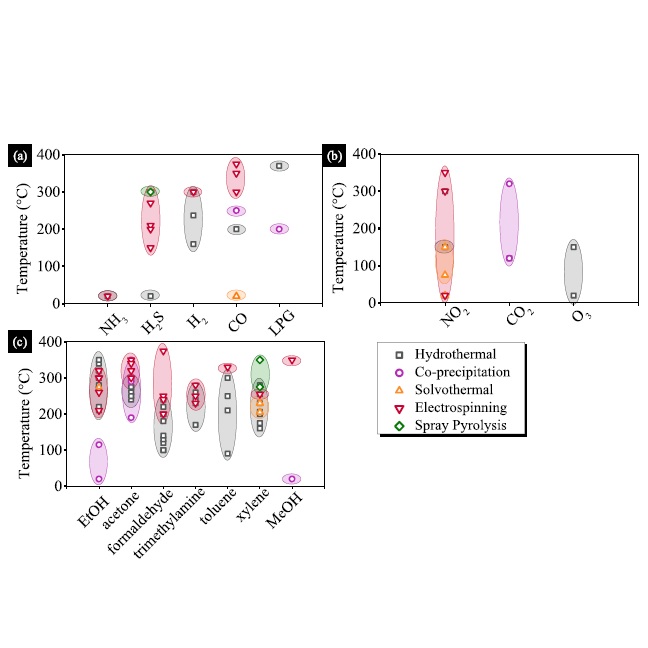Insights into nano-heterostructured materials for gas sensing: a review.
JOSHI, Nirav Kumar Jitendrabhai; BRAUNGER, Maria Luisa; SHIMIZU, Flávio M.; RIUL JUNIOR, Antonio; OLIVEIRA JUNIOR, Osvaldo Novais de.
JOSHI, Nirav Kumar Jitendrabhai; BRAUNGER, Maria Luisa; SHIMIZU, Flávio M.; RIUL JUNIOR, Antonio; OLIVEIRA JUNIOR, Osvaldo Novais de.




 Abstract: Highly sensitive and selective gas sensors with low energy consumption and amenable to miniaturization are required for real-time gas monitoring applications. The challenge is to produce sensing units at a sufficiently low cost to allow for broad deployment, which can only be reached with efficient materials and fabrication procedures. In this context, metal oxides are promising for next-generation gas sensors due to their high surface-area-to-volume ratio, efficient electron transfer, enhanced and tunable surface reactivity, fast response, and short recovery time. However, sensors from metal oxides are normally not sufficiently selective and have to be operated at high temperatures. These limitations have been overcome with strategies such as doping with other oxides, UV-illumination, and noble metal decoration. This review concentrates on the design and mechanisms of heterostructures for gas sensors, which are obtained with metal oxides in conjunction with other materials (e.g. other metal oxides and 2D materials). The key topics discussed include: (a) synthesis of metal oxide heterostructures (MOHs); (b) semiconducting heterostructures comprising n?n, n?p, and p?p heterojunctions, with emphasis on their sensing mechanisms; (c) sensors produced with heterostructures involving 2D materials. The challenges and prospects for gas sensors based on MOHs are also discussed.
Abstract: Highly sensitive and selective gas sensors with low energy consumption and amenable to miniaturization are required for real-time gas monitoring applications. The challenge is to produce sensing units at a sufficiently low cost to allow for broad deployment, which can only be reached with efficient materials and fabrication procedures. In this context, metal oxides are promising for next-generation gas sensors due to their high surface-area-to-volume ratio, efficient electron transfer, enhanced and tunable surface reactivity, fast response, and short recovery time. However, sensors from metal oxides are normally not sufficiently selective and have to be operated at high temperatures. These limitations have been overcome with strategies such as doping with other oxides, UV-illumination, and noble metal decoration. This review concentrates on the design and mechanisms of heterostructures for gas sensors, which are obtained with metal oxides in conjunction with other materials (e.g. other metal oxides and 2D materials). The key topics discussed include: (a) synthesis of metal oxide heterostructures (MOHs); (b) semiconducting heterostructures comprising n?n, n?p, and p?p heterojunctions, with emphasis on their sensing mechanisms; (c) sensors produced with heterostructures involving 2D materials. The challenges and prospects for gas sensors based on MOHs are also discussed. @article={003040168,author = {JOSHI, Nirav Kumar Jitendrabhai; BRAUNGER, Maria Luisa; SHIMIZU, Flávio M.; RIUL JUNIOR, Antonio; OLIVEIRA JUNIOR, Osvaldo Novais de.},title={Insights into nano-heterostructured materials for gas sensing: a review},journal={Multifunctional Materials},note={v. 4, n. 3, p. 032002-1032002-39},year={2021}}
@article={003040168,author = {JOSHI, Nirav Kumar Jitendrabhai; BRAUNGER, Maria Luisa; SHIMIZU, Flávio M.; RIUL JUNIOR, Antonio; OLIVEIRA JUNIOR, Osvaldo Novais de.},title={Insights into nano-heterostructured materials for gas sensing: a review},journal={Multifunctional Materials},note={v. 4, n. 3, p. 032002-1032002-39},year={2021}}